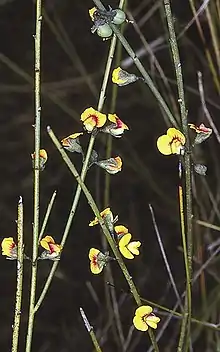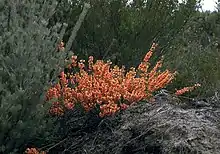Sphaerolobium vimineum
Sphaerolobium vimineum, commonly known as leafless globe-pea,[2] is a species of flowering plant in the family Fabaceae and is endemic to Australia. It is an erect, rush-like, mostly leafless shrub with yellow and reddish flowers arranged in small groups along the stems.
| Sphaerolobium vimineum | |
|---|---|
 | |
| In Morton National Park | |
| Scientific classification | |
| Kingdom: | Plantae |
| Clade: | Tracheophytes |
| Clade: | Angiosperms |
| Clade: | Eudicots |
| Clade: | Rosids |
| Order: | Fabales |
| Family: | Fabaceae |
| Subfamily: | Faboideae |
| Genus: | Sphaerolobium |
| Species: | S. vimineum |
| Binomial name | |
| Sphaerolobium vimineum | |

Description
Sphaerolobium vimineum is an erect, rush-like shrub that typically grows to a height of 0.3–1.2 m (1 ft 0 in – 3 ft 11 in) and is more or less leafless. The leaves, when present, are linear to lance-shaped and up to 8 mm (0.31 in) long. The flowers are arranged in groups of 2 or 3 along the branches on a peduncle up to about 0.5 mm (0.020 in) long, each flower on a pedicel 1–3 mm (0.039–0.118 in) long with egg-shaped bracts, and bracteoles 1.5–3 mm (0.059–0.118 in) long at the base of the sepals. The sepals are green with dark grey spots, 3–4 mm (0.12–0.16 in) long and joined at the base, with overlapping lobes, the two upper lobes forming a wedge-shaped "lip". The standard petal is elliptic, 5–6 mm (0.20–0.24 in) long and yellow with a red base, the wings longer than the keel. Flowering occurs from September to December and the fruit is a spherical pod 3–5 mm (0.12–0.20 in) in diameter.[2][3]
Sphaerolobium minus is a similar species but has uniformly grey sepals, the wings about the same length as the keel and the wings much longer than broad.[4]
Taxonomy and naming
Sphaerolobium vimineum was first formally described in 1805 by James Edward Smith in the Annals of Botany.[5][6] The specific epithet (vimineum) means "having long, flexible twigs or shoots".[7]
Distribution and habitat
Leafless globe-pea usually grows in heath and forest from south-east Queensland, along the coast and tablelands of New South Wales, through the higher rainfall parts of southern Victoria, west to the far south-east of South Australia, and south to Tasmania. It is also widespread in the Esperance Plains, Jarrah Forest, Swan Coastal Plain and Warren bioregions of south-western Western Australia.[2][3][8][9]
References
- "Sphaerolobium vimineum". Australian Plant Census. Retrieved 19 June 2022.
- Jeanes, Jeff A. "Sphaerolobium vimineum". Royal Botanic Gardens Victoria. Retrieved 19 July 2022.
- Wiecek, Barbara; Murray, Louisa. "Sphaerolobium vimineum". Royal Botanic Garden Sydney. Retrieved 19 July 2022.
- Crisp, Michael D. (1993). "Reinstatement of Sphaerolobium minus (Fabaceae: Mirbelieae)". Telopea. 5 (2): 337–339. Retrieved 19 July 2022.
- "Sphaerolobium vimineum". APNI. Retrieved 19 July 2022.
- Smith, James Edward (1805). "Remarks on the generic Characters of the Decandrous Papilionaceous Plants of New Holland". Annals of Botany. 1: 509. Retrieved 19 July 2022.
- Sharr, Francis Aubi; George, Alex (2019). Western Australian Plant Names and Their Meanings (3rd ed.). Kardinya, WA: Four Gables Press. p. 336. ISBN 9780958034180.
- Jordan, Greg. "Sphaerolobium". University of Tasmania. Retrieved 20 July 2022.
- "Sphaerolobium vimineum". FloraBase. Western Australian Government Department of Biodiversity, Conservation and Attractions.